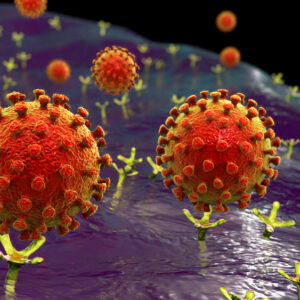Flavivirus Receptors
The Native Antigen Company manufacturers highly purified virus-host cell receptors using state-of-the-art expression and purification techniques. On request we can also undertake custom preparation of recombinant and native proteins for a broad range of disease states.
Flavivirus Receptors Background
Viruses are obligate intracellular pathogens and consequently need to gain entry into a host cell for completion of their life cycle. In order to enter to a cell, viruses attach to specific receptor molecules on the cell surface; molecules which also play an important role in normal cell function. Different viruses have evolved complex mechanisms to bind to these membrane-associated proteins and gain access to the cell interior.
Flaviviridae are small enveloped positive strand RNA viruses of an approximate diameter of 50 nm, which replicate in the cytoplasm of their respective host cell. The flavivirus family includes many mosquito-borne viruses, including Dengue virus (DENV), Yellow fever virus (YFV), West-Nile virus (WNV), Japanese encephalitis virus (JEV), Zika virus (ZIKV) and tick-borne encephalitis virus (TBEV), as well as blood-borne hepatitis C virus (HCV) (Knipe & Howley, 2013).
Flaviviruses enter cells by interaction of their E glycoprotein with cell surface receptors; these allow the virions to absorb onto the cell surface and enter the cells through receptor-mediated endocytosis. Secondary receptors may also be utilised to puncture the membrane or for fusion with the host cell. A specific receptor for internalization of flaviviruses into host cells has not yet been identified. It is believed that flaviviruses make initial contact with the host cell by binding to glycosaminoglycans (GAGs), such as heparan-sulfate proteoglycans or syndecans. However, the identity of the cellular receptors that mediate flavivirus entry and infection is still poorly known. A large number of attachment molecules such as DC-SIGN have been described as flavivirus candidate receptors in different cell types, but their precise role in virus endocytosis remains obscure. The best-characterized candidate proteins to date are C-type lectin receptors (CLEC5A) and the phosphatidylserine receptors, T-cell immunoglobulin and mucin domain (TIM) and TYRO3, AXL and MER (TAM) (Perera-Lecoin, et al., 2014; Laureti, et al., 2018).
Therefore, the E protein and its putative receptor and attachment molecules make promising targets for the design of antivirals and vaccine development.
References
- Knipe, D. M. & Howley, P., 2013. Fields Virology. Sixth ed. s.l.:LWW.
- Laureti, M., Narayanan, D. & et al., 2018. Flavivirus Receptors: Diversity, Identity, and Cell Entry. Front Immunol., Volume 9, p. 2180.
- Perera-Lecoin, M., Meertens, L. & et al., 2014. Flavivirus Entry Receptors: An Update. Viruses, 6(1), p. 69–88.
Flavivirus Receptors
We offer a range of flavivirus receptors comprising highly purified recombinant proteins known to bind to a broad spectrum of viruses.
Questions?
Check out our FAQ section for answers to the most frequently asked questions about our website and company.



